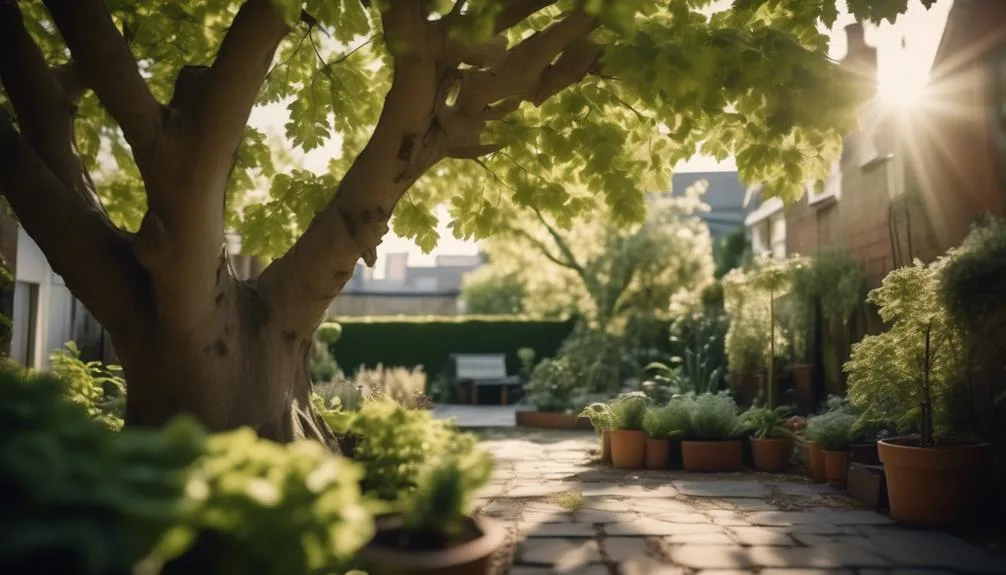Considering a sycamore tree for your small garden? These towering beauties can reach up to 100 feet in height with a 60-foot spread. However, their size and extensive root system can be challenging for compact garden spaces.
Yet, there are reasons why sycamores could still be a good choice for your garden.
Sycamore Tree Size and Space Requirements
When planting a sycamore tree in a small garden, it's essential to consider its size and space requirements to ensure it thrives in its environment. Sycamore trees can grow to be quite large, so it's crucial to choose a location with enough space for the tree to reach its full potential.
When landscaping with a sycamore tree in a small garden, consider the mature size of the tree and plan accordingly. Regular sycamore tree pruning is also important to maintain its size and shape within the limited space. Proper pruning not only helps control the tree's growth but also promotes its overall health.
Sycamore Tree Root System and Garden Impact
Considering the impact of a sycamore tree's root system on your garden is crucial, especially when planting in a small space where its size and space requirements must be carefully managed. Understanding the root depth and potential for soil compaction is essential for maintaining a healthy garden ecosystem.
Here's what you need to know:
- Root Depth: Sycamore tree roots can extend deeply into the soil, often reaching depths of 24 inches or more. This deep root system allows the tree to access water and nutrients from lower soil layers, but it also means that planting shallow-rooted plants near a sycamore may lead to competition for resources.
- Soil Compaction: The expansive root system of a sycamore tree can lead to soil compaction, especially in smaller garden spaces. This can restrict the growth of other plants and reduce the overall health of the garden.
Understanding these factors can help you make informed decisions when incorporating a sycamore tree into your small garden.
Sycamore Tree Maintenance in Small Gardens
To effectively maintain a sycamore tree in a small garden, regular pruning and monitoring of its growth are essential. Proper pruning techniques not only help in controlling the size of the tree but also contribute to its overall health and appearance. When pruning, focus on removing dead or diseased branches, as well as any crossing or rubbing branches that may cause damage. Additionally, monitoring the tree for signs of disease is crucial for disease prevention. Keep an eye out for symptoms such as unusual leaf discoloration, leaf spots, or unusual growths. Early detection can help in taking necessary measures to prevent the spread of diseases. Below is a table summarizing key pruning techniques and disease prevention tips for maintaining a sycamore tree in a small garden:
| Pruning Techniques | Disease Prevention |
|---|---|
| Remove dead or diseased branches | Monitor for signs of disease |
| Trim crossing or rubbing branches | Promptly address any signs of disease |
| Thin out dense areas to improve air circulation | Regularly inspect leaves and branches |
| Avoid heavy pruning during the growing season | Maintain overall tree health |
Sycamore Tree Benefits and Drawbacks for Small Gardens
Maintaining a sycamore tree in a small garden not only involves regular pruning and disease monitoring, but also understanding its benefits and drawbacks in this limited space.
Sycamore trees offer several advantages, such as providing shade, adding to the aesthetics with their striking mottled bark, and serving as a valuable wildlife habitat.
However, there are drawbacks to consider. Their large size can overwhelm small gardens, their roots may cause issues with nearby structures, and the shedding of bark and leaves can create maintenance challenges.
Despite these drawbacks, sycamore trees can significantly enhance the visual appeal of a small garden and provide a habitat for various wildlife species, making them a valuable addition if managed carefully.
Sycamore Tree Alternatives for Small Gardens
When selecting trees for a small garden, it's important to consider alternatives to sycamore trees that can thrive in limited space while offering similar benefits. Here are some tree species that are suitable for small gardens and can provide shade, beauty, and wildlife support:
| Tree Species | Mature Height | Benefits |
|---|---|---|
| Japanese Maple | 15-25 feet | Stunning foliage, ideal for small gardens |
| Dogwood | 15-25 feet | Beautiful flowers, attracts birds and butterflies |
| Dwarf Evergreen | 10-12 feet | Year-round greenery, compact size |
When designing a small garden, it's crucial to select trees that fit the available space without overwhelming it. Consider the mature height, spread, and overall shape of the tree to ensure it complements your garden design.
Conclusion
Considering the potential issues with their size and root system, it's important to carefully weigh the benefits and drawbacks of planting sycamore trees in small gardens.
Alternatives like Japanese maple or dwarf tree varieties can offer similar beauty without the maintenance challenges.
Choose wisely for a thriving garden.

My interest in trees started when I first saw the giant sequoias in Yosemite.
I was a teenager then, and I remember thinking, “I need to learn more about this.”
That moment stuck with me.
A few years later, I went on to study forestry at Michigan Tech.
Since graduating, I’ve worked in a mix of hands-on tree care and community education.
I’ve spent over ten years helping people understand how to plant, maintain, and protect the trees in their neighborhoods.
I don’t see trees as just part of the landscape.
They are living things that make a real difference in our daily lives.
